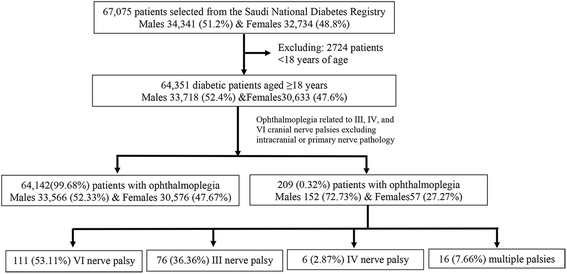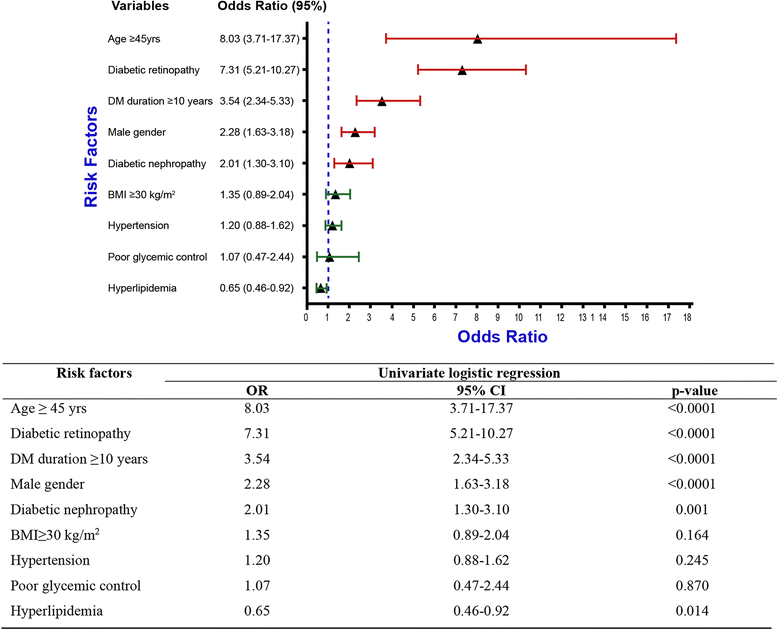Assessment of the prevalence and risk factors of ophthalmoplegia among diabetic patients in a large national diabetes registry cohort
- PMID: 27449153
- PMCID: PMC4957375
- DOI: 10.1186/s12886-016-0272-7
Assessment of the prevalence and risk factors of ophthalmoplegia among diabetic patients in a large national diabetes registry cohort
Abstract
Background: There are limited data on the epidemiology and risk factors of ophthalmoplegia among diabetic patients. This study aims to determine the prevalence and important risk factors related to ophthalmoplegia among diabetic patients.
Methods: This is an observational registry-based study using the Saudi National Diabetes Registry (SNDR) database to select diabetic patients regardless of their diabetes type. A total of 64,351 Saudi diabetic patients aged more than 18 years and registered in SNDR between January 2000 and December 2010 were analyzed to identify ophthalmoplegic cases. Demographic, clinical, and biochemical parameters were studied and STROBE guidelines were used to design and report the results of this study.
Results: The overall prevalence of ophthalmoplegia cases was 0.32 %, further distributed into: 53.11 %, 36.36 %, and 2.8 % for cranial nerves VI, III, IV palsies respectively. Ophthalmoplegic cases were predominantly type 2 diabetic males with older age and longer diabetes duration. The most important and significant risk factors were age ≥ 45 years, diabetes duration ≥ 10 years, male gender and presence of retinopathy and nephropathy.
Conclusions: Ophthalmoplegia is a rare entity associated mainly with type 2 diabetes. Clinicians have to consider its risk factors when screening or planning for prevention of this condition.
Keywords: Diabetes mellitus; III cranial nerve palsy; IV cranial nerve palsy; Ophthalmoplegia; VI cranial nerve palsy.
Figures
Similar articles
-
Diabetic retinopathy and its risk factors in a society with a type 2 diabetes epidemic: a Saudi National Diabetes Registry-based study.Acta Ophthalmol. 2015 Mar;93(2):e140-7. doi: 10.1111/aos.12532. Epub 2014 Oct 1. Acta Ophthalmol. 2015. PMID: 25270515
-
Retinopathy in patients with diabetic ophthalmoplegia.Ophthalmology. 2003 Aug;110(8):1545-50. doi: 10.1016/S0161-6420(03)00542-6. Ophthalmology. 2003. PMID: 12917170
-
Ophthalmoplegia in diabetes mellitus: a retrospective study.Acta Diabetol. 2009 Mar;46(1):23-6. doi: 10.1007/s00592-008-0053-8. Epub 2008 Aug 29. Acta Diabetol. 2009. PMID: 18758685
-
Diabetic nephropathy and its risk factors in a society with a type 2 diabetes epidemic: a Saudi National Diabetes Registry-based study.PLoS One. 2014 Feb 21;9(2):e88956. doi: 10.1371/journal.pone.0088956. eCollection 2014. PLoS One. 2014. PMID: 24586457 Free PMC article.
-
Simultaneous, multiple cranial neuropathies in diabetes mellitus.J Neuroophthalmol. 1995 Dec;15(4):219-24. J Neuroophthalmol. 1995. PMID: 8748558 Review.
Cited by
-
Keeping an eye on the diabetic foot: The connection between diabetic eye disease and wound healing in the lower extremity.World J Diabetes. 2022 Dec 15;13(12):1035-1048. doi: 10.4239/wjd.v13.i12.1035. World J Diabetes. 2022. PMID: 36578874 Free PMC article. Review.
-
Acupuncture for ophthalmoplegia: Protocol for a systematic review.Medicine (Baltimore). 2018 Jun;97(24):e11065. doi: 10.1097/MD.0000000000011065. Medicine (Baltimore). 2018. PMID: 29901611 Free PMC article.
-
Unilateral Pupil Sparing: Viral Oculomotor Neuritis With Concomitant Vestibular Neuritis.Cureus. 2021 Oct 22;13(10):e18979. doi: 10.7759/cureus.18979. eCollection 2021 Oct. Cureus. 2021. PMID: 34820234 Free PMC article.
-
Isolated trochlear palsy as the only presentation of midbrain infarction: a case report.J Int Med Res. 2021 Apr;49(4):3000605211008292. doi: 10.1177/03000605211008292. J Int Med Res. 2021. PMID: 33906530 Free PMC article.
-
Prevalence of diabetic retinopathy in the Eastern Mediterranean Region: a systematic review and meta-analysis.J Int Med Res. 2022 Oct;50(10):3000605221117134. doi: 10.1177/03000605221117134. J Int Med Res. 2022. PMID: 36314851 Free PMC article.
References
-
- El Mansouri Y, Zaghloul K, Amraoui A. Oculomotor paralyses in the course of diabetes--concerning 12 cases. J Fr Ophtalmol. 2000;23(1):14–8. - PubMed
-
- Greco D, Gambina F, Pisciotta M, Abrignani M, Maggio F. Clinical characteristics and associated comorbidities in diabetic patients with cranial nerve palsies. J Endocrinol Invest. 2012;35(2):146–9. - PubMed
Publication types
MeSH terms
LinkOut - more resources
Full Text Sources
Other Literature Sources
Medical



